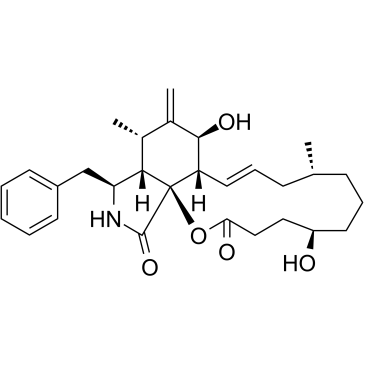Farnesylpyridinium, an analog of isoprenoid farnesol, induces apoptosis but suppresses apoptotic body formation in human promyelocytic leukemia cells.
Masahiro Hamada, Kyo-ichi Nishio, Matsumi Doe, Yoshinosuke Usuki, Toshio Tanaka
Index: FEBS Lett. 514(2-3) , 250-4, (2002)
Full Text: HTML
Abstract
1-Farnesylpyridinium (FPy), an analog of isoprenoid farnesol, initially induced morphological changes similar to those of typical apoptosis in human leukemia HL-60 cells but FPy-treated cells were characterized by the absolute absence of final apoptotic events such as fragmentation into apoptotic bodies. FPy-induced cell death was considered to be apoptotic on the basis of the induction of DNA fragmentation and the protection against these events by the coaddition of a pan-caspase inhibitor. The increase in the cytoplasmic cytochrome c level supported the possibility that FPy-treated cells should have the ability to complete the entire apoptotic process ending in cell fragmentation and apoptotic body formation. At concentrations too low to induce apoptosis, FPy could suppress the induction of apoptotic body formation in HL-60 cells by typical inducers of apoptosis such as actinomycin D or anisomycin. FPy exhibited a cytochalasin-like effect on spatial arrangement of actin filament independent of its apoptosis-inducing activity.
Related Compounds
| Structure | Name/CAS No. | Molecular Formula | Articles |
|---|---|---|---|
 |
Dihydrocytochalasin B
CAS:39156-67-7 |
C29H39NO5 |
|
Tetraploidization increases sensitivity to Aurora B kinase i...
2012-07-01 [Cell Cycle 11(13) , 2567-77, (2012)] |
|
Centrifugal and chromatographic analyses of tryptophan and t...
2003-02-28 [J. Biochem. Biophys. Methods 55(2) , 127-40, (2003)] |
|
Degradation and recycling of the substrate-binding subunit o...
1996-07-05 [J. Biol. Chem. 271(27) , 16369-74, (1996)] |
|
Complex regulation of human neutrophil activation by actin f...
1997-06-01 [J. Leukoc. Biol. 61(6) , 703-11, (1997)] |
|
Disruption of the actin cytoskeleton leads to inhibition of ...
2000-08-25 [Exp. Cell Res. 259(1) , 35-53, (2000)] |